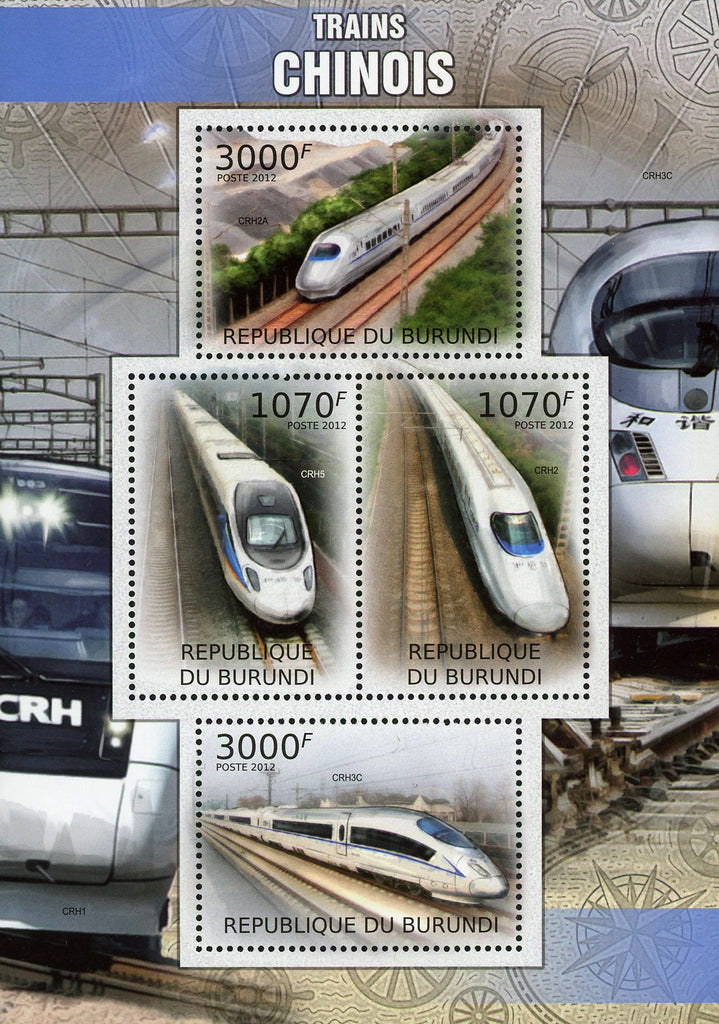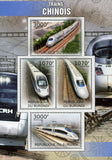Chinese Trains Transportation High Speed Sov. Sheet of 4 Stamps MNH
- Product Sku:
- Categories Republic of Burundi, Trains and Locomotives, Transportation Stamps
Chinese Trains Transportation High Speed Sov. Sheet of 4 Stamps MNH
High-speed rail (HSR) in China consists of a network of passenger-dedicated railways designed for speeds of 250–350 km/h (155–217 mph). It is the world's longest high speed railway network, and is also the most extensively used. China's HSR accounts for two-thirds of the world's total high-speed railway networks. In 2019, China started testing a magnetic levitation ("maglev") prototype train that runs at 600 km/h.
By the end of 2018, HSR extended to 30(31) of the country's 33(34) provincial-level administrative divisions[N 1], the exceptions being Macau, Ningxia, and Tibet, and reached 29,000 km (18,000 mi) in total length, accounting for about two-thirds of the world's high-speed rail tracks in commercial service. The HSR building boom continues with the HSR network set to reach 38,000 km (24,000 mi) in 2025.
Almost all HSR trains, track and service are owned and operated by the China Railway Corporation under the brand China Railway High-speed (CRH). The China Railway High-speed (CRH) high-speed train service was introduced in April 2007 featuring high-speed train sets called Hexie Hao (simplified Chinese: 和谐号; traditional Chinese: 和諧號; pinyin: Héxié Hào; literally: 'Harmony') and Fuxing Hao (simplified Chinese: 复兴号; traditional Chinese: 復興號; pinyin: Fùxīng Hào; literally: 'Rejuvenation') running at speed from 250 km/h to 350 km/h on upgraded/dedicated high-speed track. The Beijing-Tianjin intercity rail, which opened in August 2008 and could carry high-speed trains at 350 km/h (217 mph), was the first passenger dedicated HSR line.
High-speed rail developed rapidly in China over the past 15 years with substantial funding from the Chinese government, especially the economic stimulus program during the Great Recession. The removal of Railway Minister Liu Zhijun for corruption and a fatal high-speed railway accident near Wenzhou in 2011 raised concerns about safety as well as affordability, financial sustainability and environmental impact.
China's early high-speed trains were imported or built under technology transfer agreements with foreign train-makers including Alstom, Siemens, Bombardier and Kawasaki Heavy Industries. Since the initial technological support, Chinese engineers have re-designed internal train components and built indigenous trains manufactured by the state-owned CRRC Corporation.
The advent of high-speed rail in China has greatly reduced travel time and has transformed Chinese society and economy. A World Bank study found "a broad range of travelers of different income levels choose HSR for its comfort, convenience, safety and punctuality."
Notable HSR lines in China include the Beijing–Guangzhou high-speed railway which at 2,298 km (1,428 mi) is the world's longest HSR line in operation, the Beijing–Shanghai high-speed railway with the world's fastest operating conventional train services and the Shanghai Maglev, the world's first high-speed commercial magnetic levitation line, whose trains run on non-conventional track and reach a top speed of 430 km/h (267 mph).
Fast & Free Shipping within U.S.A.
We Care for your order, Pack it carefully and ship it within 24 hours.
Satisfaction Guaranteed!
Please explore our store for more stamps, souvenir sheets, post-office collectibles and philately books and pre-philatelic items:
montecinos.philately



















